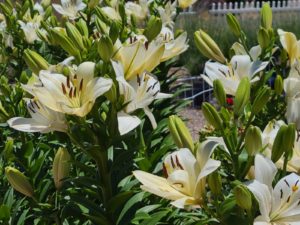This article was written by Valerie Phipps and was published in
October 1, 2014 issue of the Chino Valley Review
Quote: ‘How lovely is the silence of growing things’ author unknown
Autumn is here and we look forward to this beautiful season. For many of us,
it is our favorite time of the year. The cool, crisp mornings are welcome
after summer’s heat and the garden plants are so happy. We find dew on them
in the mornings, and sometimes there is a cool, moist fog hugging the
lowlands until the sun burns it away.
It’s Planting Time!
September is the best time of the whole year to plant trees, shrubs and
perennials and spring-blooming bulbs. Planting in the fall eases transplant
shock and allows time to establish a good strong root system before winter
arrives. Once spring comes, the plants will be able to grow and thrive.
Plant new plants by digging a hole twice as wide and as deep as the
container. Check for good drainage by filling the hole at least half full of
water and monitoring it to see how long it takes for the water to drain
away. If there is still standing water after several hours, you may have
poor drainage and will need to take steps to fix that problem. Plants do not
thrive in poor drainage situations because the roots need to breathe.
If the water does not drain away fast enough, it stagnates and the roots rot
and die.
There may be a layer of caliche, which is a natural material of calcium
carbonate that binds other materials such as silt, sand, gravel or clay into
a non-permeable substance. You can punch holes into the bottom of the hole
so that it can drain if the caliche is a thin layer. If it is a thick layer,
you may have to move your planting hole to a different location.
Some other options are planting on a mound, or digging a French drain to
carry the water away from the planting hole.
So don’t be shy, get out there and plant something!
Spring Bulbs
When you plant spring-blooming bulbs such as daffodils, tulips and
hyacinths, remember to add bone meal or bulb food to each planting hole to
ensure greater flower production.
Tiny bulbs like crocus and grape hyacinth need food, too. Remember that
tulip bulbs are like candy to javalinas. Plant those in pots out of reach of
animals.
Veggie Beds
Fall is a great time to clean up those beds where the veggies are done
producing. By cleaning up and amending these beds now, you have a jump start
on being ready for spring planting. Pull out the old vegetable plant
material and put it on your compost pile, omitting any diseased plants.
These should go into the trash bin so they will not spread their problem.
Dig up the bed and then add some amendments such as compost, mulch,
well-rotted manure, bone meal, alfalfa meal and/or worm castings. Work them
into the soil and cover the whole bed with a 4 inch layer of straw, watering
it well to moisten everything. Then leave it alone until spring except for a
once or twice a month watering during the winter. Another option is to plant
a cover crop such as rye or clover. Let it grow into early spring, then till
it under for a green manure.
Planting onions and garlic
Now is a great time to plant onion sets and garlic cloves. Plant them in
your amended beds making sure they are covered with straw. Plant them so
that the very tip of the set or clove is visible. Water them at the time you
plant and then every 2 weeks or so all through the winter. They will start
to grow now and will take off in early spring giving you onions and garlic
by June or July. Plant them at the edge of your garden so that once the
tops start to die off next summer, you can stop watering them.
Look for other timely garden information in the future.
Check out our website at www.antelopegardenclub.com.
If you love to garden or are just beginning to learn, join us for a meeting.
Times and dates are posted on our website.
Written by Valerie Phipps ACNP



No comments.